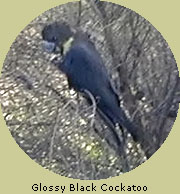|
35°38' S, 137°18' E
Lathami Conservation Park is on the drive to the North Coast going
toward Stokes Bay.
This park is named for the subspecies of Glossy Black Cockatoo
of which about 250 remain. The subspecies is found only on Kangaroo
Island. This park is dedicated to the careful nurturing and protection
of Glossy Black Cockatoos and is slowly increasing their numbers.
This subspecies of Glossy Black Cockatoo is endangered and now
only occurs frequently on Kangaroo Island and some very rare sightings
on the Fleurieu Peninsula. Once found as far North as Adelaide,
the subspecies has been almost totally confined to Kangaroo Island
for the last two decades. Breeding programmes and safe nesting
boxes have helped to stabilise and then slowly increase the numbers
of birds.
The main predator of Glossy Black Cockatoos is the Brush Tail
Possum, which has been found to take the single egg or chick from
many nest hollows.
Much of the Drooping She-oak feeding habitat was cleared and now
replanting of these trees ensures a food supply for the birds.
The extremely small seeds of the Drooping She-oak are remarkably
picked from the cones by the enormous beaks of the Cockatoos.
This is their only food source.
Glossy Black Cockatoos can be found in American River and Lathami
Conservation Park and where nest hollows were in short supply,
nesting boxes have been supplied.
Conservation of these beautiful birds has been a major programme
on Kangaroo Island and it is hoped that in time the bird will
be seen often flying with its lazy wing action across the skies
of the Island.
The Glossy Black Cockatoos future is far from gloomy. A local
initiative to save the Cockatoo from extinction is ongoing and
so far very successful. This programme guarantees, that the Glossy
Black Cockatoo will be seen by generations of visitors to come.
|